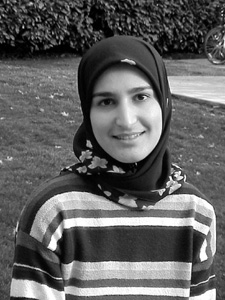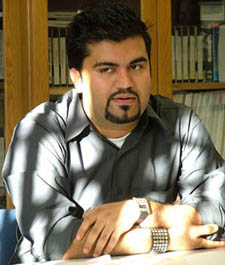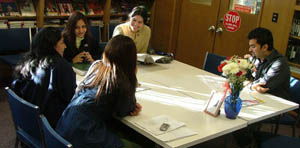Nargas Oskui-Tabrizi interprets the world in two languages. Her flawless English roots her in the United States, where she was born and where she plans to remain. But her fluent Farsi connects her to Iran, where her parents grew up and where her extended family still lives. By speaking both languages, Oskui-Tabrizi is able to relate to the world in two ways - from the independent American mindset as well as from the family-centered Iranian worldview. She describes bilinguism as a valuable learning tool. "When you speak two languages, you think in two languages," she says. "It gives you more flexibility in how to study and how to relate to society."
Now a graduate student of educational leadership, Oskui-Tabrizi teaches Farsi at the Yamada Language Center, a language learning service center on the University of Oregon campus. Designed to offer an alternative to traditional language instruction, the center allows patrons to control the pace of their learning. By offering classes and resources for the study of more than a dozen languages, from Farsi to Vietnamese to Swahili, the center encourages students and community members to broaden their international awareness.
A Place for Language Learning
Named in honor of Osamitsu Yamada, a tax accountant whose $250,000 donation was matched by the state of Oregon, the Yamada Language Center opened in 1992 as a resource center for students and faculty members studying and teaching languages at the university. Since then, it has expanded to encourage cultural exchanges and a host of language learning services.
The center serves students and teachers as well as international and linguistic groups on campus. More than sixteen departments and organizations—including the American English Institute, the Center for Applied Second Languages, and the Northwest Indian Language Institute—use the Yamada Language Center's resources.
The center's director, Jeff Magoto, has seen Yamada evolve since he joined the staff in 1996. One of the most popular developments has been the self-study program, which allows students and community members to study languages seldom offered elsewhere, at their own pace and with self-defined goals.
"People learn languages for lots of different reasons, and one thing that universities are learning is that you need to have more alternatives to the five-days-a-week, grammar-intensive structure generally offered," says Magoto. "Language learning is in fits and starts. It's not linear. But right now our teaching structures are linear and academic."
To offer language learners an alternative, the self study program was launched in the winter term of 1997. Three students of Arabic and three students of Hebrew signed up. "We had no idea what we were doing," says Magoto. "We thought, naively, that if we gave them the materials and gave them a place to study, they could do it themselves."
Trial and error proved that language students need some structure and feedback in their learning process, so Magoto and his staff began to seek tutors to guide the self-study classes. Enrollment increased steadily. In the winter term of 2004, 81 students enrolled in ten self-study courses.
Language Intersects with Culture
Self-study student Jed Bowser first became interested in learning Farsi after befriending an Iranian woman through an online chat room. She asked him about Oregon, and he asked her about Iran. He realized how little he knew about Iranian culture.
"I was so out of touch," says Bowser. "I grabbed a National Geographic from 1985, and I started relaying the information to her, and she was like, 'No. No. No. Where are you getting your information? '"
Bowser decided to educate himself about Iranian culture. "I started reading books. It's hard to find good books about Iran here in the States," he says. "Americans don't know much about other cultures. People use stereotypes as facts."
By studying Farsi at the language center, Bowser replaced those stereotypes with a growing awareness of a complex country. "Once you understand the language and its context," he says, "you start to understand the culture."
Oskui-Tabrizi agrees that language and cultural understanding are interconnected. She often opens class with a clip from an Iranian television show or a sample of music to expose her students to the sounds of the spoken language and the norms of Iranian society. "I try to infuse each class with at least five minutes of cultural learning," she says.
Magoto encourages the tutors to show this kind of initiative. Because the self-study classes are offered for variable credit on a pass/no pass basis, tutors are free to explore the aspects of language and culture that most interest their students.
"Language learning doesn't happen in one week, one month or one year," says Magoto. "And the cultural part—understanding what a people is like—that doesn't happen in a lifetime. If you try to learn a language without learning about a people, your understanding is going to be incomplete."
Because of its commitment to multicultural exchanges, the center makes an effort to employ international tutors. Of the fifteen current self-study tutors, thirteen were born outside the United States. One of these is Hindi tutor Aashim Tyagi, an undergraduate student of multimedia design.
Tyagi grew up in a multilingual environment. Four languages were spoken in his family home in India: Hindi, English, Marathi and Gujarati. When Aashim was eleven years old, his family moved to Singapore, where his friends spoke conversational "Singlish," a blend of English, Malay, Mandarin, and Tamil. So when Tyagi started teaching Hindi at the language center in 2001, he viewed his classroom as a place to test his students' cultural assumptions.
"Teaching Hindi in English is a very different phenomenon than the other languages," he says. "There is a certain population that is very fascinated with the idea of India, rather than the reality. The class became a discussion about India and Hindi."
Tyagi shows his students Hindi movies to stimulate discussions about Indian culture. "My class is driven more from a cultural point than a language aspect," says Tyagi. "The moment my students start investing themselves in the whole culture, it shows."
The Future of the Yamada Language Center
Although the Yamada Language Center has received much use from the campus community, its funding is limited. The center is staffed by four part-time professional workers and more than thirty student assistants, which makes consistency difficult.
Magoto would like to see the center acquire more resources, but he is realistic about the future. "I think we'll be more materials-resource rich and human-resource poor. And that's part of a larger trend in the university to have money for things but not money for people," he says. "We've been lucky to have a staff that is willing to go the extra mile to make language learning a better experience for the students."
Beyond its implication for individual learners, Magoto sees language learning as a way to foster greater international cooperation. "The response to terrorism is not bombs, but talk and dialogue and real understanding," he says. "We live in a multicultural, diverse society, and language is just one of the tools that is able to bridge the gaps that keep us apart."




